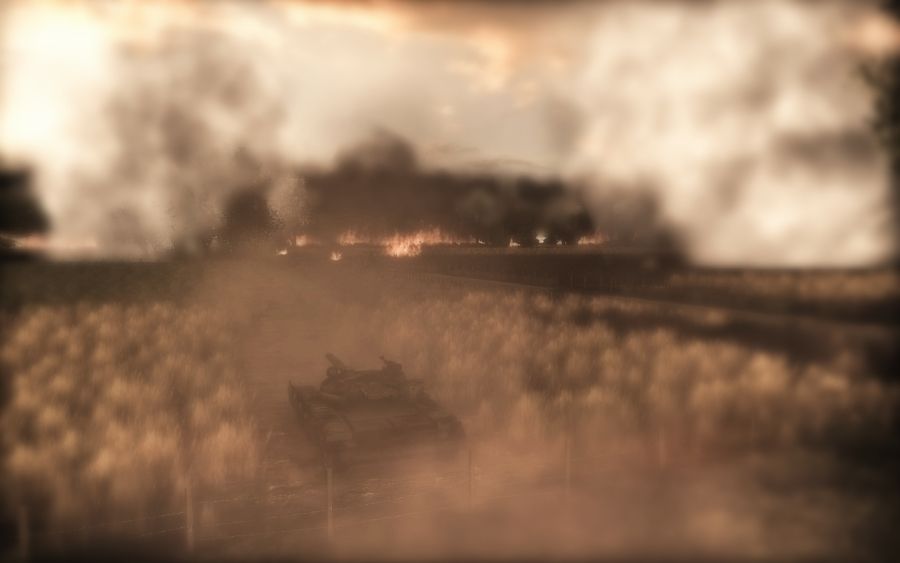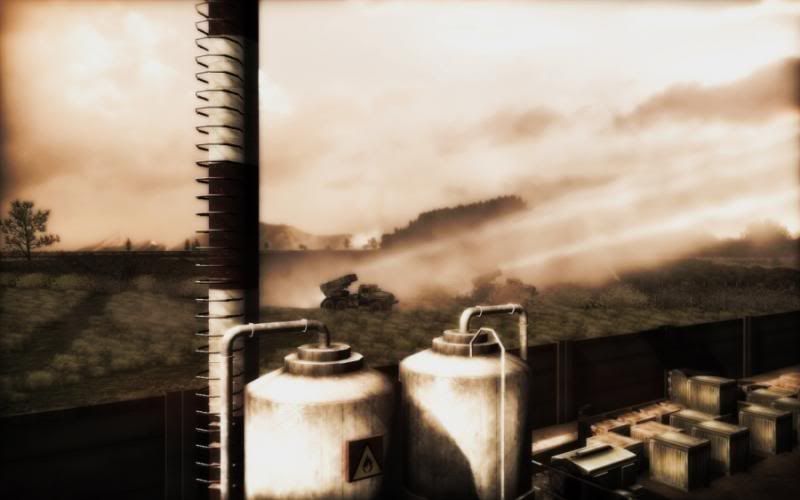“How could you possibly allow the election of a citizen of a socialist country as pope?!?" - Yuri Andropov, then head of the KGB [1]
In the tumultuous events of World War III, perhaps the most tumultuous was the so-called "Polish Summer" of 1982. While short-lived, largely the result of the brutal Soviet reprisals upon Poland, the Polish uprising of that hot August caused a great deal of chaos within Pact ranks while it existed.
It is now known that the cause for this revolt, also known as the 'Stanislaw Uprising", was the attempted KGB assassination of Pope John Paul II. While initially blamed upon a Turkish "lone wolf", evidence quickly mounted to the contrary conclusion: that this attempt on the pontiff's life was a tightly-controlled "wet op" locally orchestrated from within the Bulgarian embassy in Italy, specifically by Bulgarian military attaché Zilo Vassilev, but most definitely managed by the KGB from afar. It is now believed that the Soviets felt such drastic action was necessary because as early as 1979 the USSR was preparing for their assault upon Western Europe and knew that Pope John Paul would staunchly oppose any such aggression, possibly even to the point of converting the Polish Solidarity movement into a fifth column. He simply had to go.
What the Soviets didn't count on was the extent of the love and respect the Polish people had for "their" pontiff. When word of the KGB involvement in the assassination attempt slowly leaked into the tightly controlled Warsaw Pact member states months later, anger and resentment flared amongst Polish troops, particularly the front echelon troops who were being ground up in some of the fiercest battles of that war. This resentment would reach a critical point when the Polish Front Commander, Alojzy Walczyk, who was beloved by his troops due to his concern over excessive casualties, was arrested and removed from command without explanation (but believed to be due to his foot-dragging on launching what he considered foolhardy attacks) and replaced by a political flunky who quickly demonstrated his ineptitude in the botched offensives of late July of that year, offensives that resulted in major Polish casualties.
By August 1 the Polish officer corps was in agreement that a revolt was necessary to precipitate Poland leaving the Warsaw Pact and withdrawing from the carnage of World War III. The actual revolt was launched a week later, early one August evening, when Polish forces turned their guns on the unsuspecting Soviet forces in the "Dimitri 4" sector of the front.
The revolt kicked off when Polish fight-bombers turned their weaponry to pre-emptive strikes against Soviet positions:
Here, a Su-7BM egresses after dropping its payload while a Su-22M4P ingresses for its attack
This threw Soviet forces into a state of chaos, something the Polish ground forces made good use of by unleashing their armor on the befuddled Soviet troops:
Polish T-72s put a line of trees to good use as cover
Before they knew it, the Soviets were facing a complete mutiny across the entire Dimitri 4 sector. Every Polish unit that could march, motor, or fly its way into combat did so to support the fight:
Even outdated ASU-85Ms, with their underpowered D70 85mm main guns, joined the fray. Note the gunship providing cover
The Soviet position was made all the worse by the fact that they were not anticipating combat this day - a quiet period of rearming and repairs was on the official agenda. So when they found themselves suddenly under attack, and from behind friendly lines no less, the Soviet command panicked and hastily threw units into the fight without care. It would cost them dearly.
Polish infantry advance on a Soviet controlled road while friendly artillery softens up enemy positions
Suffering as they were under the yoke of iron-fisted Soviet control, the Polish forces showed no mercy in the fight. Prisoners were rarely taken, and napalm was often mercilessly used to remove the presence of Soviet infantry:
A Polish T-72 heads into a napalmed area
It is a credit to the Soviets that they did recover their balance once they had figured out what was going on. It was at that point that the Poles started meeting stiffening resistance and had to call on reinforcements from rear echelon troops:
BWP-2Ds fire at enemies, while a convoy of reinforcing BRDM-2s, sporting Malyutka-P ATGMs, move up a road and into battle
As the early evening dragged on, the fight just became more intense:
A Su-7BKL drops another load of napalm on the battlefield
A unit of Piechota ZMech. head into the fight after the napalm mostly burned itself out
It is believed that this is the same unit of Piechota ZMech. ambushing a Soviet BMP with RPG. The surrounding terrain still had spot fires from the napalm
Sadly, this blood feud that raged between former compatriots would spill over and into the surrounding civilian countryside. As the Soviets sought to regain their footing, they sought the natural shelter of the surrounding civilian structures, gambling that the Poles would not risk angering the very people they would, no doubt, be seeking as friends now that they were declaring their independence from the Pact. They were wrong.
Sadly, this blood feud that raged between former compatriots would spill over and into the surrounding civilian countryside. As the Soviets sought to regain their footing, they sought the natural shelter of the surrounding civilian structures, gambling that the Poles would not risk angering the very people they would, no doubt, be seeking as friends now that they were declaring their independence from the Pact. They were wrong.
Two BM-21 GRADs unleashes a salvo of rockets....
...Upon a civilian industrial center sheltering Soviet troops
Soon, both sides were actively engaged within local towns and commercial centers:
Indeed, it was not long before the homes of the local populace was caught up in the battle:
A pair of BWP-2D's guard a road leading into a suburban complex
Soon, both sides were actively engaged within local towns and commercial centers:
A missile streaks from a garage - no doubt occupied by a Polish ATGM team - while a destroyed Soviet AD unit burns on the road, probably a prior victim
Wrecks of armored vehicles of all sorts soon littered formerly quiet communities:
A Soviet tank burns in front of this house
Sadly, the irate Polish forces did not deign to spare enemy occupied towns from the wrath of napalm:
A napalm-fired conflagration burns out of control in the near distance
By the time the sun had almost set, it was clear that the Poles had the upper hand. Soviet forces were retreating everywhere in a desperate attempt to consolidate their position. Sensing the general withdrawal, Polish troops pushed the attack:
Two squads of Polish infantry sprint across a captured industrial park
A Polish Mi-24W gunship supports ground troops as they clean out Soviet troops from a civilian apartment complex
Nothing was permitted to stand in the way of a Polish victory:
More horror for the locals: napalm leaves an ugly gash right across civilian housing
The resultant firestorm as seen from a nearby industrial park
It was all too much for the Soviets. As darkness finally fell, the Wojsko Polskie had shattered all opposition in the sector. It was a great triumph. When word finally made it into Poland, great throngs of people would flood streets across the nation in celebration. Sadly, as mentioned previously, such celebrating would not last long for while the Soviets were dumbfounded by the events of this August day, the great Russian bear would soon shake off its shock and exact a terrible revenge.
But that is a tale for another time....
Footnote:
[1] George Weigel, Witness to Hope: The Biography of Pope John Paul II (New York: HarperCollins, 1999), 279. Yes, that is a real quote! While you might be inclined to think my tale was a wild flight of fancy, it is actually based on more than a little truth. For the whole fascinating story behind the 1981 attempted assassination of Pope John Paul II, look here.
Footnote:
[1] George Weigel, Witness to Hope: The Biography of Pope John Paul II (New York: HarperCollins, 1999), 279. Yes, that is a real quote! While you might be inclined to think my tale was a wild flight of fancy, it is actually based on more than a little truth. For the whole fascinating story behind the 1981 attempted assassination of Pope John Paul II, look here.





















These have been very entertaining if I do say so myself.
ReplyDeleteThanks so much! I always had more fun telling people about a particular gaming session than just playing the game. This particular narrative was a necessity due to me playing a Red vs Red skirmish game. It was interesting how it worked out. The first time it was me as the Poles, along with an easy AI controlling more Poles, versus a medium AI Soviet battle group. We lost; the AI chased us all the way back to our base. So that go-round wasn't good for an AAR. The second time it was me and a medium AI (Polish troops again) versus a medium AI who controlled a Soviet naval brigade. That time we won by chasing the AI off the map. Too easy for a narrative. For this fight it was me and a medium AI (Poles) versus a hard AI mechanized Soviet brigade. As the story says, we did win, but it was not as easy a fight. Perfect for an AAR!
ReplyDeleteAnother interesting thing about these WALB stories is how they had shown me that each map has its own coloring. While I do photoshop some of the images, I don't apply general color shifts. In other words, on this map there was a definite brownish look to everything, something that definitely conveyed a dusk-like situation. Other maps have a stormy blue-gray to them, while yet others have a bright summer day yellow edge. Really interesting how Eugen managed to suggest time and weather without actually having dynamic time and weather (which would be kinda cool!).
Thanks again!